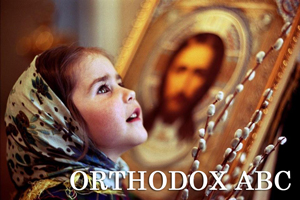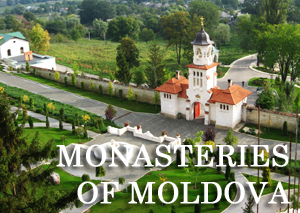
Abbess: Hegumeness Epistimia Goncearenco
Location: about 12 km South-West from Chisinau, 7 km from Ialoveni
Contact data:
MD-6827, Suruceni village, Ialoveni raion
Phone: 0268 33 262
Mobile: 069189146
At about 12 km away from Chisinau, near the village of Suruceni, on the slope of a forested hill, surrounded by vineyards and orchards, near the bank of Suruci rivulet, is the Holy Great-Martyr George monastery of nuns, or Suruceni Monastery. It is considered that the Monastery was founded in 1785.
Chronicles relate that the land on which the monastery was build was donated by the landlord Casian Suruceanu. Hieromonk Iosif, who came from Montenegro, was supported by a group of Suruceni dwellers to cut the woods on the hill slope and build the wooden church of St. George. The church construction was finished by 1794.
Thus, hieromonk Iosif became the first spiritual leader of the skete (1785-1794), consecrated the newly-built church, and gathered about 20 monks around the St. George monastic settlement.
Little is known about the elder monks who conducted the settlement before 1812, when Basarabia became part of Russia, as a result of a war with the Turkish empire. Between 1812 and 1918 the skete was conducted by 24 elders in succession. The most remarkable of them was hieromonk Bonifatie who presided the community twice: between 1812 and 1820, and since 1824 till 1832. It is mentioned in the monastic chronicles that in 1817 the skete’s church was of wood, while between 1825 and 1828, hieromonk Bonifatie, supported by the settlement’s ctitor Casian Suruceanu, built a stone church in the place of the old wooden church. The church was consecrated in 1828, also in the name of Holy Great-Martyr George.
The settlement existed initially in conditions of deep poverty, and numerous pleas for support were made to the church authorities. In 1836, two sons of Casian Suruceanu – Ioan and Teodor – donated a two big plots of land to the Monastery. The lands were at a considerable distance from the skete, and their administration was rather complicated, due to a small number of monks in the settlement. The monks still lived in conditions of severe poverty, as all incomes were used for the church maintenance and production of church vestments and inventory. Responding to the monastery’s appeal for support, the diocesan authorities suggested that the settlement offered to rent their lands, orchard, and farm, to peasants, so that they could gain some resources for the needs of the monastery. However, this decision was firmly opposed by the settlement’s ctitors, and the monks continued to work the land on their own, supported by lay Christians who offered to perform various obediences (works) in the monastic household.
The monastery’s hegumen Victor (1856-1858) was supported by the Suruceanu family to start the construction of St. Nicolas’ winter church in the monastery. The construction was finished in the winter of 1860, during the administration of the new hegumen – Fr. Anatolie (1859-1869). Besides, several administrative and household buildings were build during this time.
In 1872 an elementary school was opened within the skete, where children could study writing, music, religion, arithmetic, and Russian. This, however, was not the first teaching and charitable experience in this monastic settlement, as before the official opening of the school, needy children of clergy had also been educated and raised within the skete. In 1878 a boarding school for orphan children from priests’ families was opened in the skete.
In 1908, Pavel Piscariov, a well-known painter and director of Fine Arts School of Chisinau, renewed the painting in the church interior and repaired the iconostas of St. Gheorge Church of the skete.
On 7th November 1909, the Suruceni skete was attributed the status of monastery. In 1910 a mill is built on its territory, and the monastery built a school in Gaureni village, where the monastery had lands that had been donated to it by the Suruceanu family. By 1912 the monastery bought about 13 hectares of forestland, while using considerable plots of its agricultural land to cultivate various sorts of grapes.
By 1918 there were 60 monks in the monastery, and possessed a little over 60 hectares of land.
On 22nd July 1918 the elder of the monastery, archimandrite Dionisie Erhan, was ordained archbishop of Ismail, and in 1920 – vicar archbishop of Chisinau and Hotin, while still conducting the monastery.
Elder Dionisie, probably, the most ambitious hegumen of the settlement, did very much for his monastery. Under his pasturing (1908 – 1934) the monastery prospered. In 1923 there were 52 monks in the settlement, and the household of the monastery possessed 10 one-storey houses, one metochion house in Chisinau, one mill, 15 hectares of vineyard, 3 hectares of orchards, 2 hectares of plough land, a kitchen garden, a lake, and a library.
Elder Dionisie cared very much for the monks’ intellectual development. He made sure all monks and brothers of the monastery knew Romanian writing and reading, and provided the monastery’s library with rare books which he had brought from the other bank of the Prut river.
In 1932 elder Dionisie Erhan was appointed bishop of Ismail, remaining honourable hegumen of the monastery. He dies in 1943 and is buried in the monastery’s church, under the Proskomedia table.
By 1940 (the year when Basarabia was annexed by the Soviet Union, according to Molotov-Ribbentrop pact) the monastery is among the most prosperous monastic settlements in the area, possessing carpentries, blacksmiths workshops, footwear workshops, and a laundry washing shop. The monastery had 2 bulls, 3 cows, 2 calves, 39 sheep. Its lands expanded to 126 hectares of plough land, 54 hectares of forestland, 6 hectares of orchards, 15 hectares of vinery, 1,5 hectares of kitchen garden, and it has a metochion stone house win 8 rooms in Chisinau.
In the years 1942-1944, when Basarabia reentered Romania, the settlement was conducted by protosingel Grigorie Capatina, succeeded by hieromonk Iron Tcacenco (1944-1947).
The last elder of the monastery is hieromonk Iosif, who conducted the settlement till 1959, the year when the monastery was closed.
The monastery came into hardship when the soviet authorities took over Basarabia in 1944. The settlement was imposed huge taxes (for example, in the year 1945-1946 the monastery had to deliver to the state 840 kg of wheat, 15 kg of wool, 12 kg of sheep cheese, 200 litres of milk), and the monastic life here came into decline.
In 1948 the monastery had to cede to the state a considerable part of its lands, as only 27 monastic had remained there, and it could not work all its property. The next year the monastic community considerably expands, accounting 97 monks who had been transferred there from other settlements that had been closed.
Despite the economic pressure, the monastery improved its economical situation after 1950, although the number of monks had reduced by that time. The community was regularly paying state taxes in kind and in cash, and by 1956 it managed to accumulate considerable incomes and reserves of food and forage. In 1957 the monastery was connected to electricity network, but already on 3rd July 1959 it was closed, its 47 monks, including the hegumen, being sent to other monasteries that were still allowed to exist. Two novices married and entered colhoz.
The monastery’s icons, vestments, and books disappeared. Hegumen Iosiv Gargalyk saved two rare icons that had been brought from Jerusalem: of the Dormition of the Theotokos and of Theotokos meeting with Elisabeth, and a silver-worked Gospel. All these were returned to the monastery what it was reopened later. The monastery’s cemetery and ossuaries of St. George church (where ctitors Casian Suruceanu and his family: wife Ecaterina and son Ioan were buried) and St. Nicolas church were devastated, the tomb of elder Dionisie Erhan was vandalized.
On the territory of the monastery the authorities created the Republican hospital of narcology, guarded by militia. St. George church was transformed into a club, it sanctuary used as stage. The dome painted in 1908 by famous panter Pavel Piskarev was padded with planks, which saved the precious painting.
St Nicholas church was transformed into hospital, its sanctuary was used as surgery ward. The ossuary under the church, containing the remains of church ctitors, was vandalized and used to store firewood. The domes and turrets of the church were destroyed, and a simple roof was built in their place. The monks’ cells were transformed into hospital wards.
After 32 years, in 1991, Suruceni monastery was reopened, as monastery of nuns. The community was inhabited by 40 nuns, conducted by abbess Alexandra Bândiu (1991-1995).
The monastery was given 24 hectares of plough land, a lake was dug in the neighbourhood.
The church and household buildings were renovated. In 1994 the renovation of St George, built in 1828, started. Thus, the church interior was painted, a new 3-storey iconostas was fitted in by Romanian artists. The church was consecrated on 15th September 1998. This important event also marked the inauguration of the monastery’s theological lyceum-seminary for girls “Queen Mary”, providing a three-year educational program, according to the Romanian model implemented in the Theological Seminary at Agapia monastery.
In the same year two new buildings were inaugurated on the territory of the monastery – dormitory for the seminary students and a block with classrooms.
Since the year 2000 the abbess of the monastery is nun Epistimia Goncearenco. Under her guidance the household of monastery was renovated and expanded, monastic cells, seminary buildings, farm buildings, sewage system were built. In 2004 the monastery’s belfry was refurbished, and in 2005, six bells were installed, including two old ones, preserved from pre-communist times.
Another very important event took place in 2005: the relics of Saints Epicted and Astion (among the first martyrs attested in the lands between the Danube and Black See) were brought to the monastery. Earlier, in 1999, the Valaam Monastery of Holy Transfiguration granted to the St. George monastery of Suruceni a part of relics of St. Antipa of Calapodesti. In 2008, during renovation works, an ossuary of 6 ctitors of St. George church was discovered.
In 2012 nun Epistimia was appointed the headmistress of the Lyceum-Seminary “Regina Maria” (Queen Mary).
Holy Relics: Holy Martyrs Epictet and Astion; St. Antipa of Calapodesti (and Valaam)
Icons and other shrines: Two much revered icons, The Saviour blessing with the Gospel, and the Theotokos with the Divine Infant “Of Suruceni”.
Author: Lidia Codreanca
The translation is adapted
 Memorial house of romanian elder Sofian Boghiu Consecrated in his native Village
Memorial house of romanian elder Sofian Boghiu Consecrated in his native Village 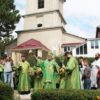 On the 14th Sunday after Pentecost, His Eminence Metropolitan Vladimir celebrated the Divine Liturgy in the St. Nicolas Monastery, Dobrusa village, Soldanesti region
On the 14th Sunday after Pentecost, His Eminence Metropolitan Vladimir celebrated the Divine Liturgy in the St. Nicolas Monastery, Dobrusa village, Soldanesti region 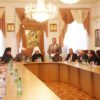 Inauguration of the volume of articles presented at the National Scientific Conference “The Orthodox Church and the State: Faith and Knowledge”
Inauguration of the volume of articles presented at the National Scientific Conference “The Orthodox Church and the State: Faith and Knowledge” 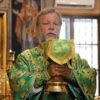 The 12th Sunday after Pentecost – kindness in God changes the world we live in
The 12th Sunday after Pentecost – kindness in God changes the world we live in  The 11th Sunday after Pentecost – loving our God and our neighbor
The 11th Sunday after Pentecost – loving our God and our neighbor 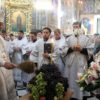 The Transfiguration of the Lord, celebrated in the Nativity of the Lord Cathedral in Chisinau
The Transfiguration of the Lord, celebrated in the Nativity of the Lord Cathedral in Chisinau  His Eminence Metropolitan Vladimir celebrates 65th anniversary
His Eminence Metropolitan Vladimir celebrates 65th anniversary  Divine Service at the St. Theodore of Tyre Monastery (Ciuflea) in Chisinau, and congratulation of Archimandrite Nicolae (Rosca), the Monastery’s confessor-administrator, on the 50th anniversary.
Divine Service at the St. Theodore of Tyre Monastery (Ciuflea) in Chisinau, and congratulation of Archimandrite Nicolae (Rosca), the Monastery’s confessor-administrator, on the 50th anniversary.  The Tenth Sunday after Pentecost: Divine Liturgy in the Nativity of the Lord Cathedral in Chisinau
The Tenth Sunday after Pentecost: Divine Liturgy in the Nativity of the Lord Cathedral in Chisinau 
